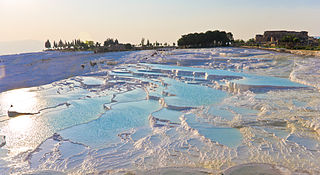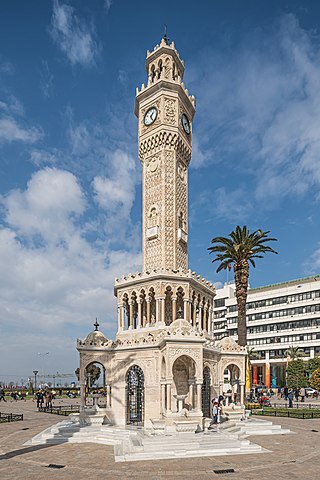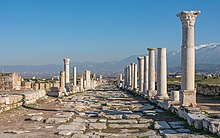
Denizli Province is a province and metropolitan municipality of Turkey in Western Anatolia, on high ground above the Aegean coast. Neighbouring provinces are Uşak to the north, Burdur, Isparta, Afyon to the east, Aydın, Manisa to the west and Muğla to the south. It is located between the coordinates 28° 30’ and 29° 30’ E and 37° 12’ and 38° 12’ N. Its area is 12,134 km2, and its population is 1,056,332 (2022). The provincial capital is the city of Denizli.

Pamukkale, meaning "cotton castle" in Turkish, is a natural site in Denizli Province in southwestern Turkey. The area is famous for a carbonate mineral left by the flowing of thermal spring water. It is located in Turkey's Inner Aegean region, in the River Menderes valley, which has a temperate climate for most of the year.

Selçuk is a municipality and district of İzmir Province, Turkey. Its area is 317 km2, and its population is 38,151 (2022). The town Selçuk is located 2 kilometres northeast of the ancient city of Ephesus, that was once home to the Temple of Artemis, one of the Seven Wonders of the Ancient World.

Burdur is a city in southwestern Turkey. The seat of Burdur Province and of Burdur District, it is located on the shore of Lake Burdur. Its population is 95,436 (2021).

Laodicea on the Lycus was a rich ancient city in Asia Minor, now Turkey, on the river Lycus (Çürüksu). It was located in the Hellenistic regions of Caria and Lydia, which later became the Roman Province of Phrygia Pacatiana. It is now near the modern city of Denizli.

Çal is a municipality and district of Denizli Province, Turkey. Its area is 860 km2, and its population is 17,889 (2022). Çal district area occupies a central position in the northern part of its province and neighbors the district of Pamukkale to the south-west and the district areas of Güney to the west and Honaz to the south. To the east of Çal district lies clockwise the districts of Bekilli, Çivril and Baklan.

Honaz is a municipality and district of Denizli Province, Turkey. Its area is 449 km2, and its population is 34,074 (2022).

Sarayköy is a municipality and district of Denizli Province, Turkey. Its area is 379 km2, and its population is 30,834 (2022). It is 20 km west of the city of Denizli, on a plain between mountains and watered by Büyük Menderes River.

Sultanhisar is a municipality and district of Aydın Province, Turkey. Its area is 220 km2, and its population is 20,230 (2022). It is 30 km east of the city of Aydın on the road to Denizli.

Acıpayam is a municipality and district of Denizli Province, Turkey. Its area is 1,772 km2, and its population is 54,888 (2022). It lies in high country between the Aegean and Mediterranean regions. A plain, watered by two reservoirs, known for growing melons and watermelons, on the road between the city of Denizli and Antalya. Its altitude is 895 m.

Bozkurt is a municipality and district of Denizli Province, Turkey. Its area is 462 km2, and its population is 12,331 (2022). The town is situated on a plain 52 km (32 mi) east of the city of Denizli. The altitude of the town is 867 m. It is quite close to the Lake Acıgöl and the neighboring town of Çardak and İnceler Kasabası

Buldan is a municipality and district of Denizli Province, Turkey. Its area is 523 km2, and its population is 26,630 (2022). Buldan district area neighbors to the east and the south three other districts of the same province, namely Güney, Pamukkale and Sarayköy, and to the west by the areas of three districts of Aydın Province, Buharkent, Kuyucak and Karacasu, and to the northwest by Sarıgöl district of Manisa Province.

Hierapolis was originally a Phrygian cult centre of the Anatolian mother goddess of Cybele and later a Greek city. Its location was centred upon the remarkable and copious hot springs in classical Phrygia in southwestern Anatolia. Its extensive remains are adjacent to modern Pamukkale in Turkey.

The Aegean Region is one of the 7 geographical regions of Turkey. The largest city in the region is İzmir. Other big cities are Manisa, Aydın, Denizli, Muğla, Afyonkarahisar and Kütahya.
Attuda or Attouda was a Hellenistic city in ancient Caria and later in the Roman province of Phrygia Pacatiana. There are coins of the place with the Greek epigraph Ἱερὰ Βουλὴ Ἀττουδέων, of the time of Augustus and later. The coins show that the Men Carus was worshipped there.

Birgi is a neighbourhood in the municipality and district of Ödemiş, İzmir Province, Turkey. Its population is 1,832 (2022). Before the 2013 reorganisation, it was a town (belde). Its current name is a corruption of its medieval Greek name, Pyrgion.
Kaklık is a neighbourhood of the municipality and district of Honaz, Denizli Province, Turkey. Its population is 4,909 (2022). Before the 2013 reorganisation, it was a town (belde).

The Ploutonion at Hierapolis or Pluto's Gate was a ploutonion in the ancient city of Hierapolis near Pamukkale in modern Turkey's Denizli Province. The site was discovered in 1965 by Italian archaeologists, who published reports on their excavations throughout the decade. Following the studies carried out on site in 1998, a geologist of the Italian National Research Council, Luigi Piccardi, recognized that the origin of both the Ploutonion and of the nearby Apollo's Oracle of Hierapolis was linked to the existence of the surface trace of a seismic fault, on which both sanctuaries were purposely built and which was revered as Gateway of Hades. In 2013, it was further explored by Italian archaeologists led by Francesco D'Andria, a professor of archaeology at the University of Salento. As part of a restoration project, a replica of the marble statue of Hades and Cerberus has been restored to its original place. The statue is known to have been there in ancient times.
The 1899 Aydın–Denizli earthquake which struck present-day Turkey on September 30 resulted in between 1,117 and 1,470 fatalities. Heavy damage was reported in the provinces of Aydın and Denizli. The shallow normal-faulting earthquake had a maximum Modified Mercalli intensity of IX (Violent). Estimates of the seismic magnitude range from 6.5 to 7.1 .


































